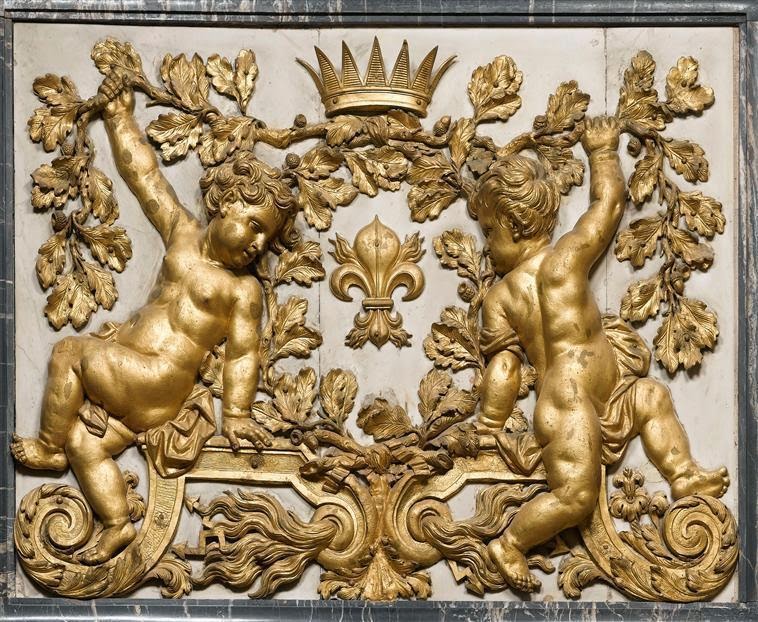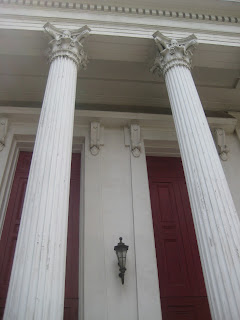Saint Luke and the Epiphany church built between 1839-1840
The main body of the building is in the form of a classical temple. The portico columns are in the Greek Corinthian order of the Choragic Monument of Lysicrates, an ancient monument in Athens. The wooden column shafts are topped with richly articulated capitals of cast iron.
In August of 2008 during my two week stay in Philadelphia for my birthday I happen upon this beautiful Greek Revival church. I was like the poparotsy outside taking photo's of this classic church. Built between 1839-1840 named Saint Luke and the Epiphany. Check out the site http://www.stlukeandtheepiphany.org/ As I was taking photo's a nice man working in the church yard spoke to me. He invited me in to tour the church. I was amazed to find the interior of this Greek Revival masterpiece was mostly all original. It was very beautiful Neo-Classical Greek Revival style architecture. He kept me talking for some time in the church as I flashed away. I was disappointed I had use my two Sunday's in Philadelphia at the Brownstone Cathedral Basilica of Saints Peter and Paul largely decorated by Constantino Brumidi! If I were not Catholic I would be Episcopalian. The people are so warm, nice and friendly. When we went back out side a older woman that go's to the church met us outside and started to fuss with my tour guide because he walked by her the other day with out speaking. She left and later came back with steamed crabs, I was still talking to my new friend and the woman offered me and the gentleman to come in and have some of her fresh steamed crabs. I had a wonderful time and met the priest and other members of this friendly church. I don't like to plan my time when I'm on holiday. I just like to take one day at a time and let the trip unfold. I always have eliciting, memorable experiments like this. Theses people were so nice and hospitable. If you are in Philly on a Sunday go to this church I know I will.
Building History
Designed by Philadelphia architect Thomas S. Stewart in 1839, the Church of St. Luke and The Epiphany was completed in 1840 for St. Luke's Church, one of the churches that formed the present parish. It is one of the finest examples of Greek Revival architecture surviving in the City.
The site was selected after other locations at Broad and Locust Streets and 13th and Spruce Streets were rejected because of cost. The land was acquired for $15,000.
Stewart's designed was chosen over six other plans submitted by several prominent architects including Thomas Strickland and John Notman. The original plan included a steeple; however, a lack of funds forced them to abandon that plan. A contract was approved to build the Church for $30,000 plus $200 for the self-supporting gallery.
The body of the church looks much as it originally did when the building was consecrated on October 16, 1840. The Philadelphia Public Ledger reported at the time: "The interior is exceedingly beautiful and chaste. Without pretending to give a detailed description, we state that above the floor every thing, even to the glass of the windows, if of a pure white, and in every section of the church is introduced the richest and most elaborate carving and molding in wood and plaster. Even the organ is of this color and in this style. It is praised as a superb instrument. The pews are represented as of oak and the damask covering them is of a corresponding color. The effect is remarkably fine."
The Chancel has undergone the most dramatic changes over the years. Originally, it was only eight feet deep and a semi-circular platform extended into the body of the church. It had a raised central pulpit behind a reading desk and communion table.
In 1853 the Chancel was torn down and a new one built in the current shape. The platform extending into the Church was removed and ten new pews added. A richly carved elevated pulpit was built to one side and a lectern placed on the other. Carved wooden benches for clergy were built on the sides and an altar placed against the rear wall. An altar rail was also added at that time. On the walls above, were inscribed the Ten Commandments and the Creed. The central circle in the ceiling was painted glass lit from windows above. In 1890 and 1891 the current brass pulpit and lectern replaced the wood ones.
When the merger with the Church of The Epiphany took place 1898, the organ from Epiphany was installed in the Chancel. Until 1925 when the current Austin organ was installed, the Church had two organs, the original in the gallery and the chancel organ.
In 1899 the Chancel was once again extended into the body of the church and the first two rows of pews in on the center aisle removed. The renovation of 1906 achieved the current look of the Chancel. The tile floor and choir stalls where installed at that time. The mosaics of St. Luke and of the symbols of the Epiphany designed by Sawyer and Flintoff were added in 1912.
The altar was moved away from the wall and placed in its current position in 1976. The cross above the altar was also added at the same time.
The stained glass windows on the main floor were added gradually between 1876 and 1899. Those in the gallery representing the Apostles were installed in 1912.
The Baptismal font, now located in the narthex since 1976, was first placed in front of the steps to the chancel. It was given to the church in 1856 by George L. Harrison, a prominent businessman and vestryman for many years. The chapel north of the Chancel was built as a Baptistry with a bequest from Asa Whitney and the font was moved there in 1876.
The Chapel and Parish House on the south side of the Church designed by Frank Furness was built by the Harrison family in 1876. Originally, the wall to the church was removed and pews placed in the chapel extending into the Church. The wall was replaced in 1891 when an addition was added to accommodate the Sunday Schools.
The exterior of the building was for many years painted brown to look like brownstone. It was changed to white in the late 1960's. The garden between the church and parish house replaced a patio in 1965.
The building is an historic landmark registered by the Philadelphia Historical Commission and is listed in the Historic American Buildings Survey of the Library of Congress.
The main body of the building is in the form of a classical temple. The portico columns are in the Greek Corinthian order of the Choragic Monument of Lysicrates, an ancient monument in Athens. The wooden column shafts are topped with richly articulated capitals of cast iron.
Beautiful Neoclassical granite steps from Quincy, Massachusetts along with fine Greek Revival cast iron .
fine Greek Revival cast iron .
Beautiful Neoclassical granite from Quincy, Massachusetts along with fine Greek Revival cast iron
Greek Revival doorway
The Baptismal font, now located in the narthex since 1976, was first placed in front of the steps to the chancel. It was given to the church in 1856 by George L. Harrison, a prominent businessman and vestryman for many years. The chapel north of the Chancel was built as a Baptistry with a bequest from Asa Whitney and the font was moved there in 1876.
In 1853 the Chancel was torn down and a new one built in the current shape. The platform extending into the Church was removed and ten new pews added. A richly carved elevated pulpit was built to one side and a lectern placed on the other. Carved wooden benches for clergy were built on the sides and an altar placed against the rear wall. An altar rail was also added at that time. On the walls above, were inscribed the Ten Commandments and the Creed. The central circle in the ceiling was painted glass lit from windows above. In 1890 and 1891 the current brass pulpit and lectern replaced the wood ones.
Other Greek-style architectural decorations include the chancel columns, which employ the same Greek Corinthian order as the front portico. The ends of the original pews are finely carved with Grecian tendrils. The frontal panels of the gallery are decorated with several types of Greek floral designs. The pilaster capitals on the walls around the interior are based on a Greek-style adaptation by the New York architect Minard Lafever and published in his pattern book, The Beauties of Modern Architecture (1835).
All of its architectural decoration was based on ancient Greek forms and details. This is vividly apparent in the interior, where the nave is dominated by a magnificent plaster-work ceiling encrusted with Greek-style decorations. One exception to this avoidance of religious symbols is the ceiling's focal point: in its center is a gilded triangle - a symbol of the Trinity - enclosing the Hebrew Tetragrammaton, the four Hebrew letters spelling the name Yahweh (God). The triangle is surrounded by gilded rays that were part of the building's original ventilation system.
In 1853 the Chancel was torn down and a new one built in the current shape. The platform extending into the Church was removed and ten new pews added. A richly carved elevated pulpit was built to one side and a lectern placed on the other. Carved wooden benches for clergy were built on the sides and an altar placed against the rear wall. An altar rail was also added at that time. On the walls above, were inscribed the Ten Commandments and the Creed. The central circle in the ceiling was painted glass lit from windows above. In 1890 and 1891 the current brass pulpit and lectern replaced the wood ones.
The Church had two organs, the original in the gallery and the chancel organ.
The ends of the original pews are finely carved with Grecian tendrils. The frontal panels of the gallery are decorated with several types of Greek floral designs.
A hand carved Greek Revival palmette or anthemion motif & egg & dart molding uses ornaments published in Minard Lafever's pattern book.































No comments:
Post a Comment